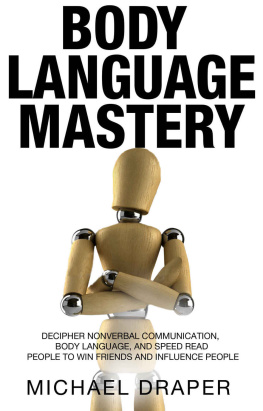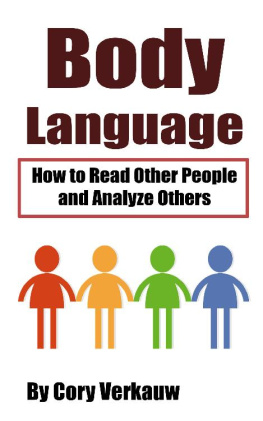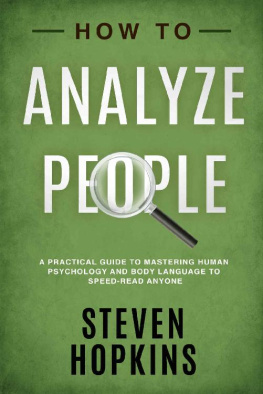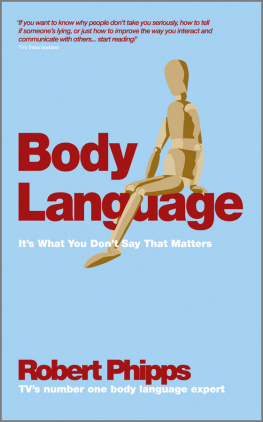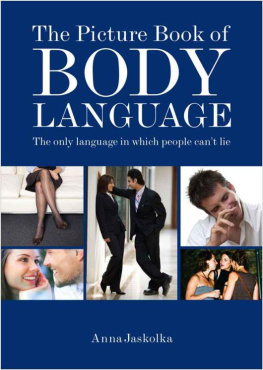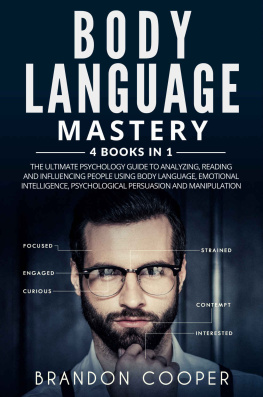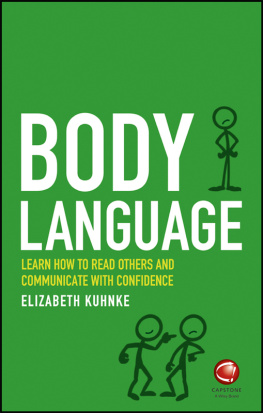Decipher Nonverbal Communication, Body Language, and Speed Read People to Win Friends and Influence People
Introduction
Consider these two near-identical scenarios; they both begin with you sat at a table of your favorite restaurant, its a busy night and you luckily got there just in time to avoid having to tip the bus boy to skip the line, and youre on the tail end of your main course in deep discussion with your friend about whether to order dessert or not. Its a treat night, why not? So here comes the waitress, she looks down at your table and asks are you finished with these? Scenario one: she asks this question with her hands made into fists on her hips, stood up straight, lips slightly pursed, and the words out of her mouth move quickly without waiting to see if you were ready to answer. Scenario two: she is bent over slightly to make better eye contact, she waits for you to finish speaking before asking, her arms wait at her side or perhaps even give a light brush off your shoulder, and she asks with a soft inflection in her voice because it is actually a question and not a rhetorical gesture.
Without any training and just from reading these two fictitious scenarios you can see exactly what was occurring and what these two waitresses were really saying and implying with their bodies. In scenario one the slightly villainous waitress was really saying hurry up because somebody else wants this table. In the second scenario she needed you to leave but she did not want to make you feel pressured, after all you might still want dessert.
Nearly all of us are capable of reading body language, and yet the rules of it can seem mysterious and we all have at one point let our body say things we didnt want it to. Even without being aware of it, you will know that sometimes a meeting or transaction goes very well and sometimes it goes terribly even without the matter of your conversation changing much at all. The reason this happens is often in the body language you, or they, have used. You said the right thing with your face and the person reciprocated with a positive vibe or, on the other hand, you might have had a stressful day and another person could read your aggression merely from the way you were standing.
For many of us, flimsy body language can cause real problems, sometimes we might appear angry when we are not, other times people might not take us seriously, or they might believe we are insincere. In many cases it is also necessary to fake body language, at one time or another we have to sell something (be it words, ideas or used cars), and we wont believe in what we are selling. Nevertheless we need our body language to say that we do. Luckily it is possible to change how you use body language, and simply being aware of which hand gesture means what and what the twitch of your eyebrows can say, you can start saying what you mean in both your words and body.
In Body Language Mastery you will be taught how body language works, what you are really saying with your body, and how to use your body, voice, and tone to say what you mean. The book will begin by looking at what science can tell us about body language and how it works in the mind; next we will explore how our bodies work to tell us things, we will then look at common body language mistakes, and finally we will look at strategies for effective communication with body language.
Chapter 1: The Science of Body Language
Just as youve turned to this book to increase your body language, so have many businesses and institutions turned to behavioral scientists and psychologists, along with ample funding, to find out what makes people tick and how body language works. So lets try to get some use out of their findings and begin with the very simple question: what is body language?
What is body language?
Body language is the way we communicate nonverbally with our bodies. That definition may be misleading because generally body language is not taken to include overt hand gestures like the raising of a thumb or middle finger, or the use of sign language those kinds of bodily gestures are in a way still verbal and direct. Body language is generally taken to be the subtle unintentional or indirect aspects of communicating with our body, even a thumbs-up can be taken as sarcastic given the right kind of smirk. In fact even some verbal communication is regarded in the same sphere as body language because how we say things is just as important as what we way. There is a middle ground here of course pointing your finger is a direct type of communication, but it can also be unintentional and figuring out what our hands are doing is definitely central to mastering body language.
Body language is the reading of our eye movements, posture, facial expressions, and how we are moving around to determine how to interpret what we are saying, and at times when we are not speaking, to interpret what a person might be thinking or feeling. Its fine not being nervous in your speech at an interview, but if you are trembling like youre experiencing an earthquake people will know you are putting it on.
The question of whether body language is intentional or unintentional is a very difficult question to conclude an answer for. There are only a few rare opportunities to ruminate and witness what is happening not only in the conversation but what is happening outside and around you, responses happen almost instinctually and youll often find yourself saying that wasnt what I intended to say, and in those cases you may begin to deconstruct your thoughts to figure out what you were thinking at the time.
Our body language seems to have even less input from our minds than this, which has led to some speaking of a conscious and a subconscious mind. This kind of division is useful for a lot of motivational speakers because it is dramatic and simplistic; your body appears to be acting on its own accord revealing your hidden desires controlling it would be some kind of hidden secret. The reality is that this division is usually flavored with leftovers of Freudian psychology which is not taken with much credibility anymore.
For the sake of simplicity it is best to think of the mind as having the bits you are currently paying attention to, and then alongside this there is a great deal of background information and processes working behind the scenes but you can easily focus in on them and alter or change them at your will. A perfect analogy is the way a computer works, normally you would run just a few programs at a time. Certain people would like you to think that your old emails and Solitaire are plotting something against you while you are distracted but this isnt the case. Body language works as part of your conscious mind, as everything you are currently doing does so, but it is also working on certain instinctual levels and working with processes that we do not fully understand - just yet!
We often hear talk of how much of our communication is down to body language, some figures suggest that 55% of what we say is located in the regions around our nose and eyes (one famous figure suggests only 7% of communication is speech). While these figures vary a lot from source to source, and its not always entirely clear what these percentages even mean in real terms, its enough to know that a significant amount of everyday communication is nearly impossible without some type of NVC (non-verbal communication). Consider how we communicate with text messages and online chat systems, it can almost seem necessary to use smiley faces and emoticons because so much of what we say can seem misleading or angry without a mouth or face behind it. A simple question such as Are you coming to the dinner party? can sound accusatory without a friendly grin next to it. Consider also how what we say is entirely related to context, it is difficult to even think of an expression that can be said outside of a situation. Take a simple phrase like thank you, this could be seen as dismissive, disingenuous, a pleasantry, or it could be seen as something extremely heartfelt if accompanied by a hug or tears.

